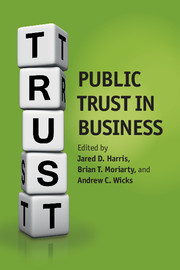Book contents
- Frontmatter
- Contents
- List of figures
- List of tables
- Notes on contributors
- Preface: discovering new territory in public trust in business
- Acknowledgments
- 1 Public trust in business: what’s the problem and why does it matter?
- Part I Trusting the institution of business
- Part II Public trust and business organizations
- 7 Public trust and trust in particular firm–stakeholder interactions: a theoretical model and implications for management
- 8 Creating more trusting and trustworthy organizations: exploring the foundations and benefits of presumptive trust
- 9 Building trust through reputation management
- 10 Can trust flourish where institutionalized distrust reigns?
- 11 Roles of third parties in trust repair: lessons from high-tech alliances for public trust
- 12 The repair of public trust following controllable or uncontrollable organizational failures: a conceptual framework
- 13 Toward a better understanding of public trust in business
- Index
- References
8 - Creating more trusting and trustworthy organizations: exploring the foundations and benefits of presumptive trust
Published online by Cambridge University Press: 05 July 2014
- Frontmatter
- Contents
- List of figures
- List of tables
- Notes on contributors
- Preface: discovering new territory in public trust in business
- Acknowledgments
- 1 Public trust in business: what’s the problem and why does it matter?
- Part I Trusting the institution of business
- Part II Public trust and business organizations
- 7 Public trust and trust in particular firm–stakeholder interactions: a theoretical model and implications for management
- 8 Creating more trusting and trustworthy organizations: exploring the foundations and benefits of presumptive trust
- 9 Building trust through reputation management
- 10 Can trust flourish where institutionalized distrust reigns?
- 11 Roles of third parties in trust repair: lessons from high-tech alliances for public trust
- 12 The repair of public trust following controllable or uncontrollable organizational failures: a conceptual framework
- 13 Toward a better understanding of public trust in business
- Index
- References
Summary
Executive summary
The situation
Low trust has become virtually a default assumption, especially when it comes to the public’s expectations regarding the fundamental trustworthiness of American business and its leaders.
Key questions
What precisely can be done to remedy this low trust in business? How can it be “fixed”? Who should do it and how might they go about doing it? How does contemporary trust theory and research move us toward any useful answers to these important questions?
New knowledge
Presumptive trust – trust that is taken for granted – is one of the bedrocks of the high trust organization. It is only when trust has a solid, secure, and virtually taken-for-granted quality that it operates at maximum effectiveness and durability.
Four key types of expectations are critical to presumptive trust in organizational settings: (1) identity-based expectations; (2) role-based expectations; (3) rule-based expectations; and (4) leader-based expectations.
Key lessons
Trust works best when it has acquired an almost tacit or taken-for-granted quality.
The constructive role that leaders play in setting positive expectations regarding the general level of trust and trustworthiness within their organizations is key to the emergence and maintenance of presumptive trust.
In situations where the costs of misplaced trust are high, too much presumptive trust can create potential vulnerabilities and risks.
Presumptive trust, without actual trustworthiness, would be a hollow achievement and potentially sets the stage for costly abuses of the public’s trust.
- Type
- Chapter
- Information
- Public Trust in Business , pp. 203 - 235Publisher: Cambridge University PressPrint publication year: 2014
References
- 1
- Cited by

